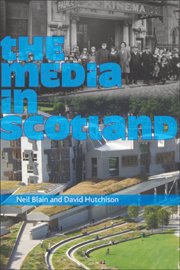Book contents
- Frontmatter
- Contents
- Preface
- Framing the Discussion
- The Historical Context
- Screen and Sound
- 7 Three Ring Circus: Television Drama about, by and for Scotland
- 8 ‘Nae Bevvying, Nae Skiving’: Language and Community in the Scottish Soap Opera
- 9 Broadcast Comedy
- 10 Contemporary Scottish Cinema
- 11 Radio and Popular Music
- Themes and Futures
- Select Bibliography
- Notes on Contributors
- Index
8 - ‘Nae Bevvying, Nae Skiving’: Language and Community in the Scottish Soap Opera
from Screen and Sound
Published online by Cambridge University Press: 05 August 2013
- Frontmatter
- Contents
- Preface
- Framing the Discussion
- The Historical Context
- Screen and Sound
- 7 Three Ring Circus: Television Drama about, by and for Scotland
- 8 ‘Nae Bevvying, Nae Skiving’: Language and Community in the Scottish Soap Opera
- 9 Broadcast Comedy
- 10 Contemporary Scottish Cinema
- 11 Radio and Popular Music
- Themes and Futures
- Select Bibliography
- Notes on Contributors
- Index
Summary
INTRODUCTION
The soap opera was one of the great cultural phenomena of the twentieth century. Appearing first on American radio during the Great Depression of the 1930s – its name deriving partly from the fact that the programmes in question were sponsored by large corporations such as Colgate-Palmolive and Procter & Gamble which produced, among other things, detergents – its key structural element was its serial format. In other words, episodes were open-ended and, in contrast to series where each episode is structured around its own self-contained narrative, in the soap opera narratives rolled, potentially endlessly, from one episode to the next. The longest-running soap opera in the World, The Guiding Light, began on American radio in 1937, made the transition to television in the early 1950s, and continues to this day, seventy years later.
The first country outside the United States to adopt the soap opera format was the UK with radio soaps such as Mrs Dale's Diary (1948-69) and The Archers (1950-), and the first television soap, The Grove Family, running from 1954 to 1957. Though these productions were broadcast throughout the UK, they were in fact English rather than in any meaningful sense British. Domestically produced Scottish soap operas would not emerge until much later, and once they did they would consistently lag in popularity behind the English soaps broadcast north of the border. This chapter will examine that apparent conundrum.
- Type
- Chapter
- Information
- The Media in Scotland , pp. 123 - 136Publisher: Edinburgh University PressPrint publication year: 2008



